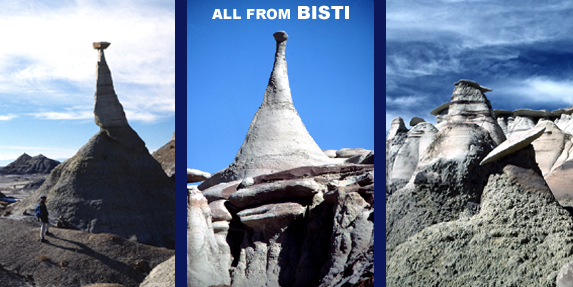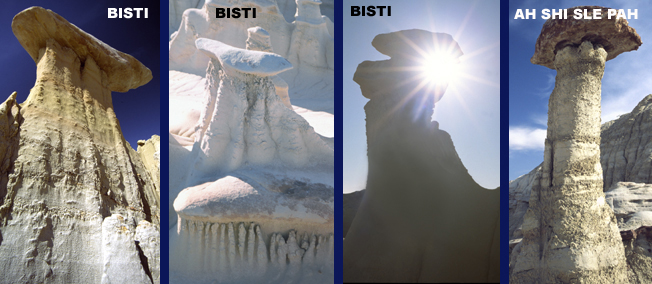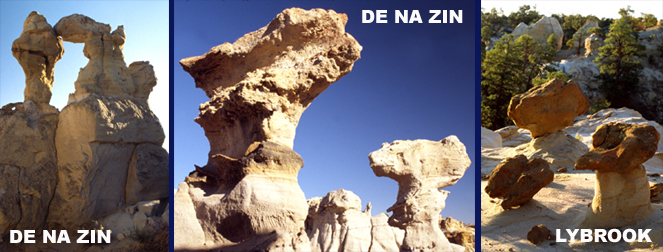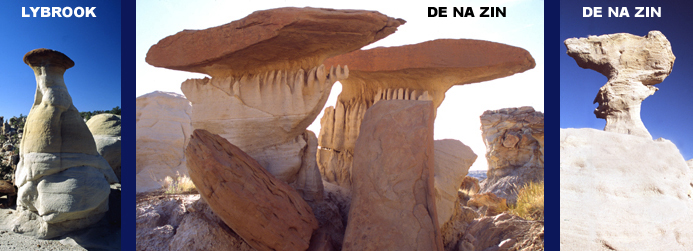
NATURE : MASTER BADLANDS SCULPTOR
HOO DOOS (link to photo tour)

What is a badland? A range of scientific definitions exist but in the San Juan Basin: a badland is a place where hoo doos are found in profusion—literally by the thousands.
What are hoo doos? Their colorful name says it all. They are unusual, “spooky” rock forms; strange shapes that appear too contrived, too artistic, too fragile to be completely natural. The classic hoo doo consists of an intricately sculpted cap rock balancing precariously atop a much thinner rock column.
Hiking through the badlands’ endless hoo doo mazes has an otherworldly feel to it—like navigating across surreal dreamscapes. The obvious first question is: How did so many weird, evocative rock forms become concentrated in the San Juan Basin Badlands?
The answer spans great distances in space and time.

NATURE’S SCULPTURE GARDENS – IMPRINTS OF THE COSMOS
Endless hoo doo gardens in the San Juan Basin Badlands never fail to stimulate the imagination. The sheer numbers, infinite variety, evocative shapes, and excessive detail of these natural sculptures invariably lead to the question: What’s the “point?” Why has nature created such an abundance of intricate, whimsical rock forms? Is this “art for art’s sake?” does nature have an inherent aesthetic spirit? Indeed many of the delicately shaped hoo doo cap rocks displayed on pedestals appear as intelligently and purposefully crafted as sculptures from a Santa Fe artist’s studio. Or are the galleries simply huge labyrinths of meaningless, random forms that only the human mind would waste time ascribing purpose to?
Another side to the riddle concerns the weirdly organic character of individual shapes and galleries as a whole. You feel you’re walking inside some gigantic cellular structure or sea creature or past the remains of a huge downed monster. Are inanimate processes reflecting a natural life force in the cosmos? Rich treasure troves of animal fossils and petrified wood found all over the San Juan Basin attest to a distant past filled with lush biological communities. Do the baroquely organic hoo doo assemblages carved from raw earth somehow mirror this fecund past?
Whether all of this is food for conjecture or just meaningless daydreaming, one thing remains true; these enigmatic forms are imprints of the cosmos itself. Rain, flowing water, wind blown sand, chemical decomposition, and temperature changes have sculpted the hoo doo galleries: but these small scale forces are caused by much grander planetary and even cosmic processes. Galactic gravitational tides, the mega fusion reactor which is our sun, colliding continental plates, our whirling planet and oceans have focused tremendous energies over vast timelines to create the Alice in Wonderland mazes that we muse over.
Is it all a joke meant to beguile the human imagination ? Are the badlands evidence for a cosmic sense of humor?

NATURE’S SCULPTING TOOLS
Badlands sculpting begins with thick, multi-colored sedimentary layers and gigantic convection currents in the Earth’s molten interior. Melted flowing rock in the deep mantle layer pushes continental sized crustal blocks up far above sea level. In the case of the San Juan Basin, rock once below sea level is now 7000-8000 feet above it. Blocks shatter with giant cracks called faults and continued localized vertical slippage produces mesas and cliff faces. Deep vents allow molten magma to force upward causing more slippage and deformation. The rising, uneven crust is ready for water, empowered by gravity, to begin sculpting as it returns to the sea.
Stream channels carve deeper into thick sedimentary layers, exposing new surfaces to the elements. Continued vertical movement along local fault lines adds still more exposed rock for wind and water to carve and shape. As individual rock formations begin appearing, wind blown sand becomes more important in creating hoo doos. Rain and wind work together to carve the characteristic columns, but it is abrasive wind blown sand that shapes intricate hoo doo cap rocks.
Surface chemical decomposition involving water, oxygen, and naturally formed acids, weaken rock and hasten the work of water and wind. Chemical reactions also produce diverse mineral hues and complex textures that color formations and enrich their surfaces. High desert temperature extremes cause daily expansion and contraction cycles that mechanically weaken rock and create small cracks where ice wedges form to pry off pieces, helping water and wind over the millennia as they carve strange never ending shapes.
Hoo doos form when a more resistant cap rock, much like an umbrella, shields a supporting column from the elements and slows its erosion compared to surrounding material. Wind blown sand shapes and smoothes hoo doo cap rocks into intricate, aerodynamic forms that seemed poised for flight. Occasionally wind completely pierces the hoo doo formation producing various sized arches.
Over millions of years all these uplift and erosional forces work together to produce the sprawling, hoo doo filled sculpture gardens that are the San Juan Basin Badlands.

| HOME |
GEOLOGY |
PHOTOGRAPHY TIPS | RECREATION | MAP - INDIVIDUAL BADLANDS |
| INDIVIDUAL BADLANDS PAGE | PHOTO TOURS |
BADLANDS OVERVIEW |
This site is property of PhotoTrekNM. All rights reserved. Copyright 2007.
